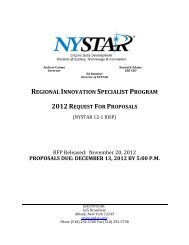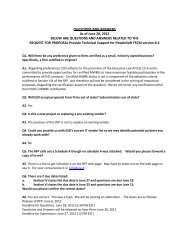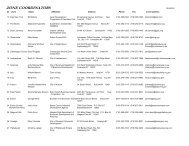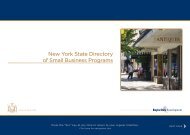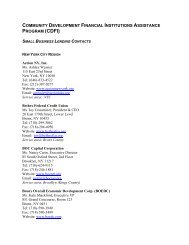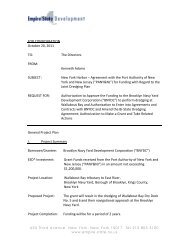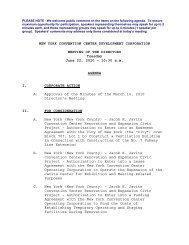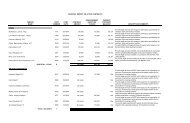NEW YORK STATE URBAN DEVELOPMENT CORPORATION d/b/a ...
NEW YORK STATE URBAN DEVELOPMENT CORPORATION d/b/a ...
NEW YORK STATE URBAN DEVELOPMENT CORPORATION d/b/a ...
You also want an ePaper? Increase the reach of your titles
YUMPU automatically turns print PDFs into web optimized ePapers that Google loves.
No groundwater will be withdrawn; excavations for buildings will not extend into the<br />
groundwater table; and no groundwater discharge is associated with the Project. In addition,<br />
stormwater management for each specific use shall be required to manage surface water flow<br />
and allow groundwater infiltration. Lastly, the storage of chemicals and petroleum shall be<br />
done in strict accordance with applicable state and federal regulations to ensure the avoidance<br />
of potential releases to groundwater and/or surface waters.<br />
The Stormwater Management Preliminary Report attached in the DGEIS evaluated the full<br />
build-out of the Project and the impact that the development may have on the Project Site. At<br />
full build out, the Project translates to an increase in impervious service areas of approximately<br />
490 acres as compared to existing conditions. Impervious surfaces will be generally introduced<br />
in the forms of buildings, roads, and parking lots.<br />
On the other hand, the Project will provide significant benefits to existing water resources<br />
including the enhancement and protection of approximately 97 acres of wetlands and 24,000<br />
linear feet of streams and upland buffers, as well as offsite wetland stream and buffer<br />
mitigation in the southeastern portion of the Whitney Creek watershed, including wetland<br />
restoration, invasive species eradication/control, planting of native vegetation, establishment<br />
of forested stream buffers, and the creation of legal mechanisms for permanent control.<br />
From a watershed perspective, preservation of existing, high-quality resources that secure<br />
connectivity between existing habitat and preservation areas is most important on the Project<br />
Site. Restoration of wetlands and stream buffers is a priority in the upper reaches of the<br />
watershed that is southeast of the Project Site where greater impacts to aquatic resources have<br />
already occurred. The mitigation strategies outlined below will yield the greatest benefit to the<br />
function of the watershed as a whole through protected enhancement of headwater streams,<br />
wetlands and stream buffers on-site and in the lower reaches, as well as restoration of<br />
wetlands and stream buffers in the highly fragmented upper reaches of the Whitney Creek<br />
watershed.<br />
Minimization and Mitigation Measures<br />
Surface water resources potentially impacted by the Project are avoided, minimized and/or<br />
mitigated to the maximum extent practicable. Design revisions made to the Project have<br />
significantly reduced potential wetland impacts from approximately 69 acres to 9.54 acres. In<br />
order to minimize and avoid impacts to surface water resources and allow for stream buffer<br />
enhancement opportunities, a minimum buffer of 100 feet shall be established on either side of<br />
Whitney Creek. In addition, the third drainage way (Unnamed Stream No. 1) shall be re-routed<br />
into the second corridor (Unnamed Stream No. 2) to accommodate flow and to provide<br />
hydrology for the enhancement and the restoration of wetlands and streams in the protected<br />
corridor.<br />
Best management practices shall be employed in order to minimize impacts to streams in other<br />
waters within the Project Site during proposed construction, utility installation and<br />
transportation facilities. The following best management practices will be implemented:<br />
14



